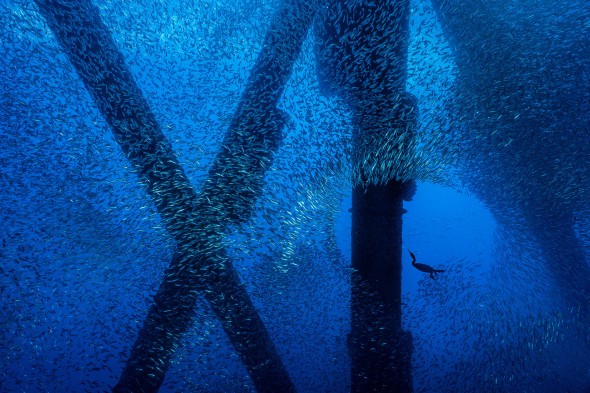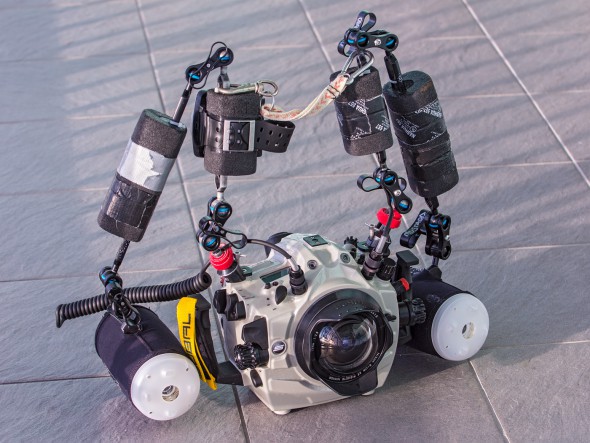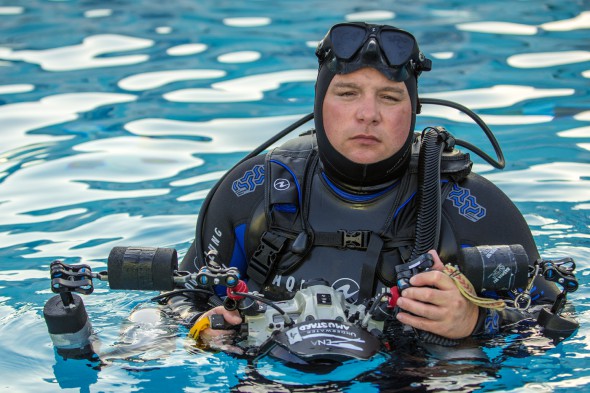This spectacular shot landed Alex Mustard in the finals of Wildlife Photographer of the Year 2016. He tells us the story behind the image

Image by Alex Mustard
Deep among the struts of an oil rig, off the coast of California’s Long Beach, a cormorant expertly bursts into a shoal of mackerel, seeking prey. Able to hide itself behind the hulking structure, the bird masks its approach until the last possible moment, catching the fish unawares.
It’s a spectacular moment, expertly captured in the image above by Alex Mustard. Alex has been taking photographs for more than three decades and is one of the world’s foremost underwater shooters. This image deservedly placed as a finalist in the Birds category of Wildlife Photographer of the Year 2016, and when we saw it we knew we had to find out more.
Read on for the story behind Alex's shot...
On the scene
“This photo I took on a trip to California. What was unusual here was that you’re not normally allowed to scuba dive beneath a working oil rig – as far as I know there are only two oil rigs in the world that allow scuba divers to dive under them.”
“It created a really interesting and unusual underwater environment, but was also very dark. This meant the shot made use of the full capabilities of the camera.”
On the approach to the shot
“I went down with this subject matter in mind, but the nature of wildlife photography is that the animals will always have a say in what you end up producing.”
“Usually underwater photographers shoot a lot with fisheye lenses, but I didn’t for this shot. This was a big decision, but I felt the nature of the oil rig meant it benefited from a non-fisheye wide-angle lens, so that was a consideration, because I definitely wanted to photograph the behaviour of the cormorant but also capture the feeling of this unusual environment.”
“That contrast between the cormorant and its man-made environment was one of those paradoxes you get drawn to as a photographer. They just give the image something – a perfect picture is always great to look at, but if a shot also has something intriguing to it, it’ll likely connect with more people.”
“Normally an oil rig of course is something that isn’t good for nature, but it’s interesting to see this thriving food chain going on below it, and actually, the story behind that is that the reason the animals do so well beneath the rig is because fishing boats can’t fish there. It’s interesting the way that one big environmental problem is providing a break from another, and that’s what drew me to wanting to shoot that environment.”
“Both the cormorants and the sea lions hunt the schools of mackerel that are under there, but the schools also tend to be quite seasonal, so my trip was very much timed to catch them at their best.”
Alex photographing schooling fish, cormorants and sealions. Filmed by Peter Rowlands from Alexander Mustard on Vimeo.
On his underwater kit setup
“This image was taken with the Nikon D4, and I now use a Nikon D5. A whole variety of wide-angle lenses are really important for underwater photography – I use three different fisheye lenses and have a whole host of wide-angle lenses, both zooms and fixed focal lengths.”

Alex's current setup. Nikon D5 camera with Nikonos 13mm UW fisheye lens (customised to work with modern SLR). Subal ND5 housing (specifically for Nikon D5). Two Seacam 150 strobes, attached with metal arms with foam floats for buoyancy.
“The key thing with underwater photography is that you take every picture very close. You can use a close-focusing macro lens, but because you can’t back away you don’t have that much flexibility and you have to use quite a lot of different focal lengths. So where the land-based photographer might have one macro lens, I have a 60mm macro, a 105mm macro and a 150mm macro. I use all of them with teleconverters and various other accessories to shoot subjects of a whole range of different sizes, from the page of a magazine down to the corner of a postage stamp.”
“One of the frustrations for the underwater photographer, but also one of the benefits, is that you can’t change lenses underwater. You really need to think about what you’re hoping to get before you go down. I have to think about what range I’m shooting at, what subject matter I want to get, and optimise my equipment to enable me to get something that’s a little special. I experiment with lighting setups, use different types of underwater flashguns, and just optimise the equipment across the board to try and get the best result.”

Alex photographed in his natural environment, from December 2016
About the Photographer
Alex Mustard is a multi-award-winning underwater photographer. He was named European Wildlife Photographer of the Year in 2013, and has been a judge for Wildlife Photographer of the Year. In 2016 he released two books – Underwater Photography Masterclass and Secrets Of The Seas. Find out more at amustard.com.
Related articles
Behind the Image: Zebra Jumping Spider, by Matt Doogue
Behind the Image: Sea of Balloons, by Sean Byrne
Behind the Image: A Sense of Perspective, by Mark Horton

